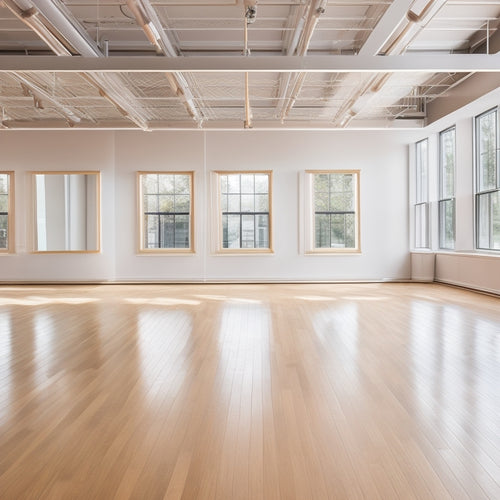
Soothe Back Pain With These Dance Exercises
Share
You can soothe back pain by incorporating specific dance exercises into your routine. Engage your core for stability, releasing muscle tension and improving posture. Pelvic clock exercises maintain spinal alignment, while hip openers and undulating movements increase flexibility. Chest expansion exercises promote healthy posture, and mindful movement cultivates relaxation. By targeting the underlying causes of back pain, you can reduce discomfort and pain. As you explore these exercises, you'll discover how to harmonize your body and calm your mind, leading to a more balanced and pain-free you - and that's just the beginning of your journey to a healthier back.
Key Takeaways
• Engage core muscles to improve posture, reduce muscle imbalances, and alleviate back pain through stable foundation and good posture.
• Release muscle tension through gentle movements, breathing exercises, and progressive relaxation to calm the nervous system and reduce physical tension.
• Improve spinal alignment and flexibility with exercises like pelvic clock, hip openers, and undulating spine movements to loosen tight muscles and promote spinal fluidity.
• Enhance chest expansion and posture by moving torso smoothly, keeping arms relaxed, and maintaining a steady breath to aid in focus and centering.
• Practice mindful movement with slow and controlled movements, synchronized breathing, and body awareness to release tension, cultivate inner calm, and reduce back pain.
Engage Your Core for Stability
When you engage your core muscles, you create a stable foundation that helps alleviate back pain by reducing strain on your spine and pelvis. This is because your core muscles, including your abdominals and lower back muscles, play an essential role in maintaining good posture and providing support for your spine. By strengthening your core, you can improve your overall posture, reduce muscle imbalances, and alleviate back pain.
As you engage your core, focus on maintaining pelvic balance. This means keeping your pelvis in a neutral position, avoiding tilting it forward or backward. When your pelvis is in balance, your spine is able to maintain its natural curvature, reducing strain on your back muscles. Developing core strength is vital for maintaining pelvic balance and alleviating back pain.
Isolate and Release Muscle Tension
As you work to alleviate back pain through dance exercises, it's crucial to focus on releasing physical tension and isolating tight muscles. By doing so, you'll improve your overall flexibility and reduce discomfort.
Now, let's explore how to release physical tension and isolate tight muscles to achieve maximum relaxation and pain relief.
Release Physical Tension
By incorporating gentle, controlled movements into your daily routine, you can isolate and release muscle tension, an essential step in alleviating back pain. This process is vital in reducing physical tension, which can exacerbate back pain.
To release physical tension, try the following exercises:
-
Practice breathing exercises: Focus on deep, slow breaths, inhaling through your nose and exhaling through your mouth. This helps calm your nervous system and relax your muscles.
-
Progressive relaxation: Tense and then relax different muscle groups in your body, starting from your toes and moving up to your head. This helps you become aware of areas of tension and release it.
-
Shoulder rolls: Roll your shoulders forward and backward in a circular motion, releasing any tension in your upper back and shoulders.
- Neck stretches: Slowly tilt your head to the side, bringing your ear towards your shoulder, and then back to the starting position. Repeat on the other side.
Isolate Tight Muscles
You can pinpoint specific areas of tension by targeting individual muscle groups, allowing you to release tight muscles that contribute to back pain. This isolation technique helps you identify and address trigger points, which are areas of hyperirritable tissue that can cause pain and stiffness. By focusing on specific muscle groups, you can release muscle knots, also known as adhesions, that restrict movement and cause discomfort.
To isolate tight muscles, start by identifying areas of tension. Lie on your back, and bring your attention to your body, scanning from head to toe. Where do you feel tightness or discomfort? Is it in your neck, shoulders, or lower back?
Once you've identified the area, engage in gentle, controlled movements to target the specific muscle group. For example, if you're experiencing tension in your neck, slowly tilt your head from side to side, then bring your ear towards your shoulder. Hold for a few seconds, and release. Repeat this process, gradually increasing your range of motion as you release tension.
Pelvic Clock for Spinal Alignment
Your pelvic clock exercise begins with lying on your back, knees bent, and feet flat on the floor, which allows you to focus on rotating your pelvis in a circular motion. This exercise is essential for maintaining spinal health and improving body awareness.
As you lie comfortably, imagine a clock on your pelvis, with 12 o'clock at your belly button and 6 o'clock at your lower back.
Rotate your pelvis in a circular motion, starting from 12 o'clock and moving clockwise. Focus on relaxing your lower back and engaging your abdominal muscles.
As you rotate, maintain a slow and controlled pace, taking about 5-7 seconds to complete one full circle.
Repeat the motion 5-7 times, then switch directions and move counterclockwise.
Take deep breaths and focus on the sensations in your pelvis and lower back, allowing yourself to release any tension or discomfort.
Hip Openers for Flexibility
Tight hip flexors can lead to a cascade of issues, including lower back pain, poor posture, and reduced mobility, making hip openers an essential component of a well-rounded exercise routine for back pain relief. As you incorporate hip openers into your routine, you'll notice a significant improvement in your overall flexibility and mobility.
To get started, try incorporating Sacred Circles into your routine. This exercise involves moving your hips in large, fluid circles, first clockwise and then counterclockwise. This gentle, flowing motion helps to loosen tight hip flexors and increase flexibility.
As you move your hips, focus on maintaining a smooth, Fluid Movement, avoiding any jerky or bouncy motions. Remember to breathe naturally and relaxed, allowing your hips to move freely.
Undulate for Spinal Flexibility
As you undulate, you'll focus on three key points to maximize spinal flexibility.
You'll learn to wave like a snake, releasing tension slowly and moving with control, allowing your spine to relax and stretch.
Wave Like a Snake
By slowly undulating your spine, you can increase flexibility and reduce stiffness in your back, mimicking the sinuous movements of a snake. This snake-like movement helps to loosen tight muscles, promoting spinal fluidity and relaxation. As you wave like a snake, you'll feel your spine lengthening and your muscles relaxing, reducing tension and discomfort.
Here's how to incorporate this exercise into your daily routine:
-
Stand with your feet shoulder-width apart, arms relaxed by your sides.
-
Take a deep breath in, and as you exhale, slowly allow your spine to curve and flex, mimicking the sinuous movement of a snake.
-
Repeat this movement several times, focusing on the gentle, flowing motion.
- As you continue to wave like a snake, bring your attention to your breath, allowing yourself to relax and release any tension or stiffness in your back.
Remember to listen to your body and modify or stop if you experience any discomfort or pain.
Release Tension Slowly
You can release tension slowly by undulating your spine, allowing your vertebrae to move freely and promoting flexibility in your back. This gentle, flowing motion helps to relax your muscles and increase blood flow, reducing stiffness and discomfort.
As you undulate, focus on your breathing exercises, taking slow, deep breaths in through your nose and out through your mouth. This helps to calm your nervous system and further relax your muscles.
To enhance the relaxation response, incorporate progressive relaxation techniques into your undulation exercise. As you move your spine, bring your attention to each vertebra, starting from the base of your skull and working your way down to your tailbone. As you focus on each vertebra, release any tension or tightness, allowing your spine to lengthen and relax.
Remember to breathe deeply and slowly, feeling your body let go of tension with each exhalation. By combining undulation with breathing exercises and progressive relaxation, you can effectively release tension and promote flexibility in your spine, alleviating back pain and improving overall well-being.
Move With Control
To undulate with control, start by standing or sitting upright with your arms relaxed by your sides. Then initiate a gentle, wave-like motion in your spine, allowing each vertebra to move freely and independently. As you undulate, focus on maintaining fluid movements, keeping your gestures balanced and controlled. This will help you develop greater spinal flexibility and reduce back pain.
Here's what it should look like:
-
Your head and neck remain still, while your torso moves in a smooth, flowing motion.
-
Your arms stay relaxed, avoiding any jerky or stiff movements.
-
Your hips and pelvis move in a gentle, wave-like pattern, without any bouncing or jerking.
-
Your breath remains steady and calm, helping you stay focused and centered.
Chest Expansion for Posture
Proper chest expansion is key to maintaining a healthy posture, as it allows your shoulders to roll back and down, releasing tension in your upper back and promoting a more upright stance. By incorporating chest expansion exercises into your daily routine, you can improve your overall posture and reduce back pain.
| Exercise | Instructions |
|---|---|
| Deep Breathing | Stand with your feet hip-width apart, inhale deeply through your nose, and exhale slowly through your mouth, focusing on expanding your chest. |
| Shoulder Rolls | Roll your shoulders forward and backward in a circular motion, releasing any tension and promoting relaxation. |
| Chest Stretch | Stand in a doorway with your hands on the doorframe at shoulder height. Lean forward, stretching your chest and shoulders. |
| Wall Push-Ups | Stand with your feet shoulder-width apart and your hands on a wall at shoulder height. Slowly lower your body toward the wall, keeping your elbows close to your body, and then push back up to the starting position. |
Mindful Movement for Relaxation
As you've worked on improving your posture through chest expansion exercises, now it's time to focus on mindful movement to relax your entire body and reduce back pain. This is where mindful movement comes in – a powerful tool to calm your mind and body. By focusing on your breath and movement, you'll be able to quiet your mind and release physical tension.
Here are some key elements to incorporate into your mindful movement practice:
-
Slow and controlled movements: Move slowly and deliberately, focusing on the sensations in your body.
-
Breathing rhythms: Synchronize your movements with your breath, inhaling and exhaling slowly and deeply.
-
Body awareness: Pay attention to areas of tension and stiffness, and release them as you move.
- Inner calm: Allow yourself to let go of stress and anxiety, and cultivate a sense of calm and relaxation.
Frequently Asked Questions
Can I Do These Exercises if I Have a Herniated Disk?
'Did you know that 80% of Americans experience back pain? If you have a herniated disk, you can still do these exercises, but it's important to focus on gentle movements and core strengthening to avoid exacerbating the injury.'
How Often Should I Practice These Dance Exercises?
To see progress, you'll need to commit to a regular practice schedule, as consistency matters. Aim to practice these dance exercises 2-3 times a week, but be flexible - scheduling challenges will arise, so adapt and don't overdo it.
Are These Exercises Suitable for Pregnant Women?
As you prepare for motherhood, imagine your body as a blooming garden, nurturing life. Yes, these exercises are suitable for pregnant women, offering prenatal benefits like flexibility and strength, and supporting postpartum recovery, under the guidance of a healthcare provider.
Can I Modify These Exercises for Knee or Hip Replacements?
You can modify these exercises for knee or hip replacements by consulting your doctor and adapting post-op rehabilitation protocols; make prosthetic adjustments and prioritize gentle, low-impact movements to guarantee a safe recovery.
Will These Exercises Help With Sciatica Pain Relief?
"In the 1920s, flappers would've been amazed to know that, today, you can find sciatica pain relief through targeted exercises. As you stretch, you'll alleviate sciatica causes, like compressed nerves, and master pain management techniques for your lower back."
Related Posts
-

Best Studio Mirrors for a Professional Dance Space
Choosing the best mirrors for your professional dance space can enhance your practice. High-quality glass mirrors pro...
-

Benefits of Wearing Activity Trackers Daily
Wearing an activity tracker daily can transform your fitness routine. You'll gain understanding into your daily steps...
-

Missouri Star Unveils New Ribbon Dance Pattern
Missouri Star Quilt Co. introduces the Ribbon Dance Pattern, a vibrant 10 Square (Layer Cake) design that showcases b...


